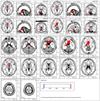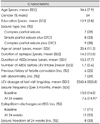1. Park SP, Kwon SH. Cognitive effects of antiepileptic drugs. J Clin Neurol. 2008. 4:99–106.

2. Loring DW, Marino S, Meador KJ. Neuropsychological and behavioral effects of antiepilepsy drugs. Neuropsychol Rev. 2007. 17:413–425.

3. Lee HW, Jung DK, Suh CK, Kwon SH, Park SP. Cognitive effects of low-dose topiramate monotherapy in epilepsy patients: A 1-year follow-up. Epilepsy Behav. 2006. 8:736–741.

4. Park SP, Hwang YH, Lee HW, Suh CK, Kwon SH, Lee BI. Long-term cognitive and mood effects of zonisamide monotherapy in epilepsy patients. Epilepsy Behav. 2008. 12:102–108.

5. Cereghino JJ, Biton V, Abou-Khalil B, Dreifuss F, Gauer LJ, Leppik I. Levetiracetam for partial seizures: results of a double-blind, randomized clinical trial. Neurology. 2000. 55:236–242.
6. Berkovic SF, Knowlton RC, Leroy RF, Schiemann J, Falter U. Levetiracetam N01057 Study Group. Placebo-controlled study of levetiracetam in idiopathic generalized epilepsy. Neurology. 2007. 69:1751–1760.

7. Meador KJ, Gevins A, Loring DW, McEvoy LK, Ray PG, Smith ME, et al. Neuropsychological and neurophysiologic effects of carbamazepine and levetiracetam. Neurology. 2007. 69:2076–2084.

8. Piazzini A, Chifari R, Canevini MP, Turner K, Fontana SP, Canger R. Levetiracetam: an improvement of attention and of oral fluency in patients with partial epilepsy. Epilepsy Res. 2006. 68:181–188.

9. Zhou B, Zhang Q, Tian L, Xiao J, Stefan H, Zhou D. Effects of levetiracetam as an add-on therapy on cognitive function and quality of life in patients with refractory partial seizures. Epilepsy Behav. 2008. 12:305–310.

10. Neyens LG, Alpherts WC, Aldenkamp AP. Cognitive effects of a new pyrrolidine derivative (levetiracetam) in patients with epilepsy. Prog Neuropsychopharmacol Biol Psychiatry. 1995. 19:411–419.

11. Ciesielski AS, Samson S, Steinhoff BJ. Neuropsychological and psychiatric impact of add-on titration of pregabalin versus levetiracetam: a comparative short-term study. Epilepsy Behav. 2006. 9:424–431.

12. Aldenkamp AP, Overweg J, Gutter T, Beun AM, Diepman L, Mulder OG. Effect of epilepsy, seizures and epileptiform EEG discharges on cognitive function. Acta Neurol Scand. 1996. 93:253–259.

13. Coq JO, Xerri C. Acute reorganization of the forepaw representation in the rat SI cortex after focal cortical injury: neuroprotective effects of piracetam treatment. Eur J Neurosci. 1999. 11:2597–2608.

14. Kristeva-Feige R, Feige B, Makeig S, Ross B, Elbert T. Oscillatory brain activity during a motor task. Neuroreport. 1993. 4:1291–1294.

15. Pulvermüller F, Eulitz C, Pantev C, Mohr B, Feige B, Lutzenberger W, et al. High-frequency cortical responses reflect lexical processing: an MEG study. Electroencephalogr Clin Neurophysiol. 1996. 98:76–85.

16. Bhattacharya J, Petsche H, Pereda E. Long-range synchrony in the gamma band: role in music perception. J Neurosci. 2001. 21:6329–6337.
17. Tallon C, Bertrand O, Bouchet P, Pernier J. Gamma-range activity evoked by coherent visual stimuli in humans. Eur J Neurosci. 1995. 7:1285–1291.

18. Pulvermüller F. Hebb's concept of cell assemblies and the psychophysiology of word processing. Psychophysiology. 1996. 33:317–333.

19. Pantev C. Evoked and induced gamma-band activity of the human cortex. Brain Topogr. 1995. 7:321–330.

20. Fell J, Fernández G, Klaver P, Elger CE, Fries P. Is synchronized neuronal gamma activity relevant for selective attention? Brain Res Brain Res Rev. 2003. 42:265–272.

21. Koles ZJ. Trends in EEG source localization. Electroencephalogr Clin Neurophysiol. 1998. 106:127–137.

22. Pascual-Marqui RD, Michel CM, Lehmann D. Low resolution electromagnetic tomography: a new method for localizing electrical activity in the brain. Int J Psychophysiol. 1994. 18:49–65.

23. Talairach J, Tournoux P. Co-planar sterotaxic atlas of the human brain: 3-dimensional proportional system-an approach to cerebral imaging. 1988. New York: Thieme Medical Publisher.
24. Towle VL, Bolaños J, Suarez D, Tan K, Grzeszczuk R, Levin DN, et al. The spatial location of EEG electrodes: locating the best-fitting sphere relative to cortical anatomy. Electroencephalogr Clin Neurophysiol. 1993. 86:1–6.

25. Pascual-Marqui RD. Review of methods for solving the EEG inverse problem. Interantional Journal of Bioelectromagnetism. 1999. 1:75–86.
26. Williams JM. Memory Assessment Scales profesional manual. 1991. Odessa, FL: Psychological Assessment Resources.
27. Wechsler D. Wechsler Memory Scale-Revised manual. 1987. San Antonio, TX: Psychological Corp..
28. Reitan RM, Wolfson D. The Halstead-Retan Neuropsychological Test Battery: theory and clinical interpretation. 1993. 2nd ed. Tucson, AZ: Neuropsychology Press.
29. Goodglass H, Kaplan E, Barresi B. Boston Diagnostic Aphasia Examination. 2000. 3rd ed. (BDAE-3). San Antonio, TX: Psychhological Corp..
30. Beck AT, Ward CH, Mendelson M, Mock J, Erbaugh J. An inventory for measuring depression. Arch Gen Psychiatry. 1961. 4:561–571.

31. Beck AT, Steer RA. Manual for the Beck Anxiety Inventory. 1990. San Antonio, TX: Psychological Corp..
32. Wagner GL, Wilms EB, Van Donselaar CA, Vecht ChJ. Levetiracetam: preliminary experience in patients with primary brain tumours. Seizure. 2003. 12:585–586.

33. Mecarelli O, Vicenzini E, Pulitano P, Vanacore N, Romolo FS, Di Piero V, et al. Clinical, cognitive, and neurophysiologic correlates of short-term treatment with carbamazepine, oxcarbazepine, and levetiracetam in healthy volunteers. Ann Pharmacother. 2004. 38:1816–1822.

34. Helmstaedter C, Witt JA. The effects of levetiracetam on cognition: a non-interventional surveillance study. Epilepsy Behav. 2008. 13:642–649.

35. Flicker L, Grimley Evans J. Piracetam for dementia or cognitive impairment. Cochrane Database Syst Rev. 2000. CD001011.

36. Schindler U. Pre-clinical evaluation of cognition enhancing drugs. Prog Neuropsychopharmacol Biol Psychiatry. 1989. 13:Suppl. S99–S115.

37. Genton P, Van Vleymen B. Piracetam and levetiracetam: close structural similarities but different pharmacological and clinical profiles. Epileptic Disord. 2000. 2:99–105.
38. Salinsky MC, Binder LM, Oken BS, Storzbach D, Aron CR, Dodrill CB. Effects of gabapentin and carbamazepine on the EEG and cognition in healthy volunteers. Epilepsia. 2002. 43:482–490.

39. Salinsky MC, Spencer DC, Oken BS, Storzbach D. Effects of oxcarbazepine and phenytoin on the EEG and cognition in healthy volunteers. Epilepsy Behav. 2004. 5:894–902.

40. Salinsky M, Storzbach D, Oken B, Spencer D. Topiramate effects on the EEG and alertness in healthy volunteers: a different profile of antiepileptic drug neurotoxicity. Epilepsy Behav. 2007. 10:463–469.

41. Veauthier J, Haettig H, Meencke HJ. Impact of levetiracetam add-on therapy on different EEG occipital frequencies in epileptic patients. Seizure. 2009. 18:392–395.

42. Devinsky O, D'Esposito M. Neurology of cognitive and behavioral disorders. 2004. 1st ed. New York: Oxford;275–329.
43. Krings T, Chiappa KH, Cuffin BN, Cochius JI, Connolly S, Cosgrove GR. Accuracy of EEG dipole source localization using implanted sources in the human brain. Clin Neurophysiol. 1999. 110:106–114.

44. Michel CM, Murray MM, Lantz G, Gonzalez S, Spinelli L, Grave de Peralta R. EEG source imaging. Clin Neurophysiol. 2004. 115:2195–2222.

45. Zumsteg D, Friedman A, Wennberg RA, Wieser HG. Source localization of mesial temporal interictal epileptiform discharges: correlation with intracranial foramen ovale electrode recordings. Clin Neurophysiol. 2005. 116:2810–2818.

46. Zumsteg D, Friedman A, Wieser HG, Wennberg RA. Propagation of interictal discharges in temporal lobe epilepsy: correlation of spatiotemporal mapping with intracranial foramen ovale electrode recordings. Clin Neurophysiol. 2006. 117:2615–2626.

47. Merlet I, Garcia-Larrea L, Grégoire MC, Lavenne F, Mauguiére F. Source propagation of interictal spikes in temporal lobe epilepsy. Correlations between spike dipole modelling and [18F]fluorodeoxy-glucose PET data. Brain. 1996. 119:377–392.

48. Cuffin BN, Schomer DL, Ives JR, Blume H. Experimental tests of EEG source localization accuracy in realistically shaped head models. Clin Neurophysiol. 2001. 112:2288–2292.





 PDF
PDF ePub
ePub Citation
Citation Print
Print






 XML Download
XML Download